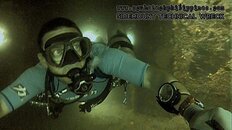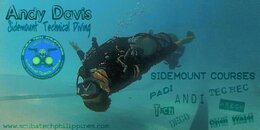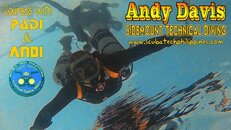ginge
Registered
Hello all.
I have been diving on and off (as finance allowed) for 15 years or so, starting with BSAC and going the PADI route on holiday in 2001.
Since then I have done a lot of dives on holiday (warm water, good vis, no exposure protection).
I approached diving as I do everything - methodically. I like doing things right (but not necessarily Doing It Right).
As such I always did a couple of review and skill refresher dives in the UK before going abroad and focus on skills while diving.
One of those skills was the complete removal and replacement of my equipment underwater to facilitate self rescue on becoming entangled where you cannot reach.
I was originally taught it by my university BSAC club in the 90s and I don't know if it is still taught.
Recently I have decided to take my diving more seriously and (since I have the funds) do more UK diving.
I have done the dry suit speciality and have been trying valiantly to get back my previously good buoyancy control with the suit on.
I have also been won over by the idea of self reliance, in truth I have dived solo more times than I can count if one doesn't include incompetent or dangerous buddies.
I am off to Mexico next month (with my life-long buddy, no insta-buddies this time) and on my return I am going to get some equipment together and focus on getting the SDI solo certification.
I already have a lot of it and I am strongly leaning towards independent back mounted twins for my breathing gas.
My idea is to have three cylinders (two on my back, one on the shore/in the boat). Breathe one down a third (leaving two thirds in it) breathe the other down two thirds and surface. Switch the mostly empty one round for a full one and then reverse the process on dive 2.
My question is about weighting though.
Currently I have a BP/W with integrated weights which I cannot remove underwater without doing an impression of a Polaris missile due to the buoyancy of the drysuit.
I have tried dumping all the air out of my drysuit to the point of squeeze but I still have +ve buoyancy.
I can't wear a weight belt due to not having a waist .
.
I am considering wearing a harness with just enough weight to keep me neutral in a mostly empty drysuit and having the rest on the BP/W. I just don't like the complexity with all the extra pinch clips and straps.
Ideally I would like to be able to shrug out of my harness have me and it both be neutral just like I have done dozens of times without the drysuit.
What would you do/do you do?
Any brilliant ideas I haven't thought about/seen?
I have been diving on and off (as finance allowed) for 15 years or so, starting with BSAC and going the PADI route on holiday in 2001.
Since then I have done a lot of dives on holiday (warm water, good vis, no exposure protection).
I approached diving as I do everything - methodically. I like doing things right (but not necessarily Doing It Right).
As such I always did a couple of review and skill refresher dives in the UK before going abroad and focus on skills while diving.
One of those skills was the complete removal and replacement of my equipment underwater to facilitate self rescue on becoming entangled where you cannot reach.
I was originally taught it by my university BSAC club in the 90s and I don't know if it is still taught.
Recently I have decided to take my diving more seriously and (since I have the funds) do more UK diving.
I have done the dry suit speciality and have been trying valiantly to get back my previously good buoyancy control with the suit on.
I have also been won over by the idea of self reliance, in truth I have dived solo more times than I can count if one doesn't include incompetent or dangerous buddies.
I am off to Mexico next month (with my life-long buddy, no insta-buddies this time) and on my return I am going to get some equipment together and focus on getting the SDI solo certification.
I already have a lot of it and I am strongly leaning towards independent back mounted twins for my breathing gas.
My idea is to have three cylinders (two on my back, one on the shore/in the boat). Breathe one down a third (leaving two thirds in it) breathe the other down two thirds and surface. Switch the mostly empty one round for a full one and then reverse the process on dive 2.
My question is about weighting though.
Currently I have a BP/W with integrated weights which I cannot remove underwater without doing an impression of a Polaris missile due to the buoyancy of the drysuit.
I have tried dumping all the air out of my drysuit to the point of squeeze but I still have +ve buoyancy.
I can't wear a weight belt due to not having a waist
I am considering wearing a harness with just enough weight to keep me neutral in a mostly empty drysuit and having the rest on the BP/W. I just don't like the complexity with all the extra pinch clips and straps.
Ideally I would like to be able to shrug out of my harness have me and it both be neutral just like I have done dozens of times without the drysuit.
What would you do/do you do?
Any brilliant ideas I haven't thought about/seen?







